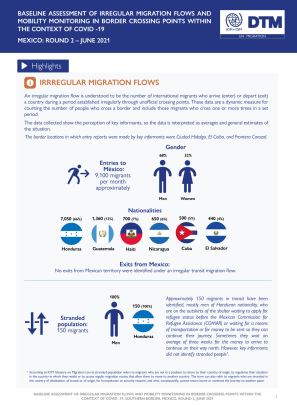-
Countries
-
Data and Analysis
-
Special Focus
-
Crisis Responses
Mexico-Baseline assessment of irregular migration flows and mobility monitoring in border crossing points within the context of COVID-19 #2 (June, 2021)

Contact
Laura Canché, lcanche@iom.int
Language
English
Location
Mexico
Period Covered
Jun 01 2021
Jun 30 2021
Activity
- Flow Monitoring Survey
- Mobility Tracking
- Event Tracking
Situation context
On June 8, the Vice President of the United States Government, Kamala Harris, visited Mexico City to meet with the Mexican President, Andrés Manuel López Obrador, in order to discuss several issues, among them the consolidation of a specialized operations group to fight migrant smuggling, as well as forensic expansion with the collaboration and training of the United States Federal Bureau of Investigation (FBI) to search for missing persons in Mexico2. Prior to the arrival of Vice President Harris in Mexico, some civil society organizations3 exposed the different problems migrants go through during their transit through Mexico toward the United States. One of these problems is that people are exposed to a series of human rights violations and felonies, such as extortion and kidnapping, due to the criminalization of migration.
The Federal Government installed the “State Interinstitutional Roundtable to Assist Asylum Seekers” in the state of Chiapas, pointing out that it is about the implementation and follow-up of the agreements of the Global Compact on Refugees. It is recognized that 70 percent of refugee and international protection applications are presented in Chiapas, and the forecast for the end of 2021 is that there will be more than 100,000 seekers.
Vaccination days against COVID-19 were carried out in Chiapas, specifically in Tapachula, Unión Hidalgo and Frontera Hidalgo, where people over 40 years old were invited to participate, regardless of their nationality. Key informants estimate the participation of at least 500 Guatemalan nationals, the majority during the first week of vaccination.
There were reports that at the Rodolfo Robles border bridge in Ciudad Hidalgo, as well as at the Talismán border, Guatemalans made up to 100 daily requests for the Regional Visitor Card (TVR). Moreover, it was estimated that approximately 1,000 migrants crossed the Suchiate River every day, a flow represented mostly by cross-border migration of Guatemalan people in irregular condition.
According to the Statistical Bulletin of the Migration Policy Unit, in June 2021 Chiapas saw 2,681 events where foreigners were returned by the immigration authority: 1,960 men and 370 women of Central American nationalities. Returns are currently carried out by land, and key informants indicated that up to ten buses depart every day from the Siglo XXI Migration Station to Tecún Umán, Guatemala. In the border crossing point of “El Ceibo”, in Tenosique, in June there were 765 events recorded of foreigners returned by the migration authorities.
On the other hand, there is an increased perception of migration flows from Central American and Caribbean nationals to North America, according to key informants from Ciudad Hidalgo and Tapachula. Particularly in Ciudad Hidalgo, key informants indicated that, previously, the town was just a crossing point; however, since last year and within the context of the COVID-19 pandemic, there are people who wait for several days in the city, mostly Central Americans who ask for money, arguing that they want to continue on their way, while some others want to return to their countries of origin.
Key informants from the city of Palenque (Chiapas) estimate that between 4,000 and 6,000 migrants arrive to the city every month. 95 percent of the people enter through Frontera Corozal. This means there is a change in mobility patterns in the presence of the National Migration Institute (INM) and the National Guard in other border locations such as Ciudad Hidalgo and El Ceibo.
